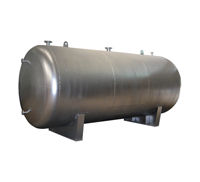27 Jun Over-temperature Reasons of Heat Transfer Fluid System Expansion Tank
 Heat transfer fluid heating system has been used in various fields based on its excellent properties including well-distributed heating, accurate temperature control, simple operation, low vapor pressure, high heat transfer efficiency, safety and environment protection. The safety and stability of fluid system operation is the main pursuing goal of fluid application.
Heat transfer fluid heating system has been used in various fields based on its excellent properties including well-distributed heating, accurate temperature control, simple operation, low vapor pressure, high heat transfer efficiency, safety and environment protection. The safety and stability of fluid system operation is the main pursuing goal of fluid application.
The fluid system is composed by heater, circulation pump, expansion tank (head tank), storage tank (lower tank), filter and other units (like thermometer, pressure gage and valves). Expansion tank is exposed to air directly in fluid system, which is used to protect system safety and extend fluid service life.
Use of Expansion Tank
Expansion tank is used to contain fluid expanding volume, supply fluid caused by system consuming and accidental leakage, and prevents fluid oxidization. Fluid in expansion tank can be used to replace system hot fluid to avoid over-temperature during emergency shutdown. Besides, some users design expansion tank to be fluid-injection tank.
Install Nitrogen Sealing
It is suggested to install nitrogen sealing in expansion tank to prevent fluid oxidization from directly exposing to air. Fluid over-temperature in expansion tank also accelerates fluid deterioration and shortens fluid service life, which should to be avoided.
Reasons of Expansion Tank Over-temperature
The main reasons of expansion tank over-temperature are shown as follow:
- The angle of expansion tube is installed improperly, which makes system fluid flow into expansion tank increasing tank temperature. Boiler should be installed strictly conforming to the design and installation specifications.
- The expansion tank is installed not high enough, which makes system fluid temperature transfer to expansion tank. So the height of expansion tank should be installed high enough.
- The auxiliary exhaust pipeline is not closed off after dehydrating and removing light substances, which makes system fluid flow into expansion tank through auxiliary exhaust pipe. The auxiliary exhaust pipeline should be closed off when system fluid is heated up to the operation temperature.

